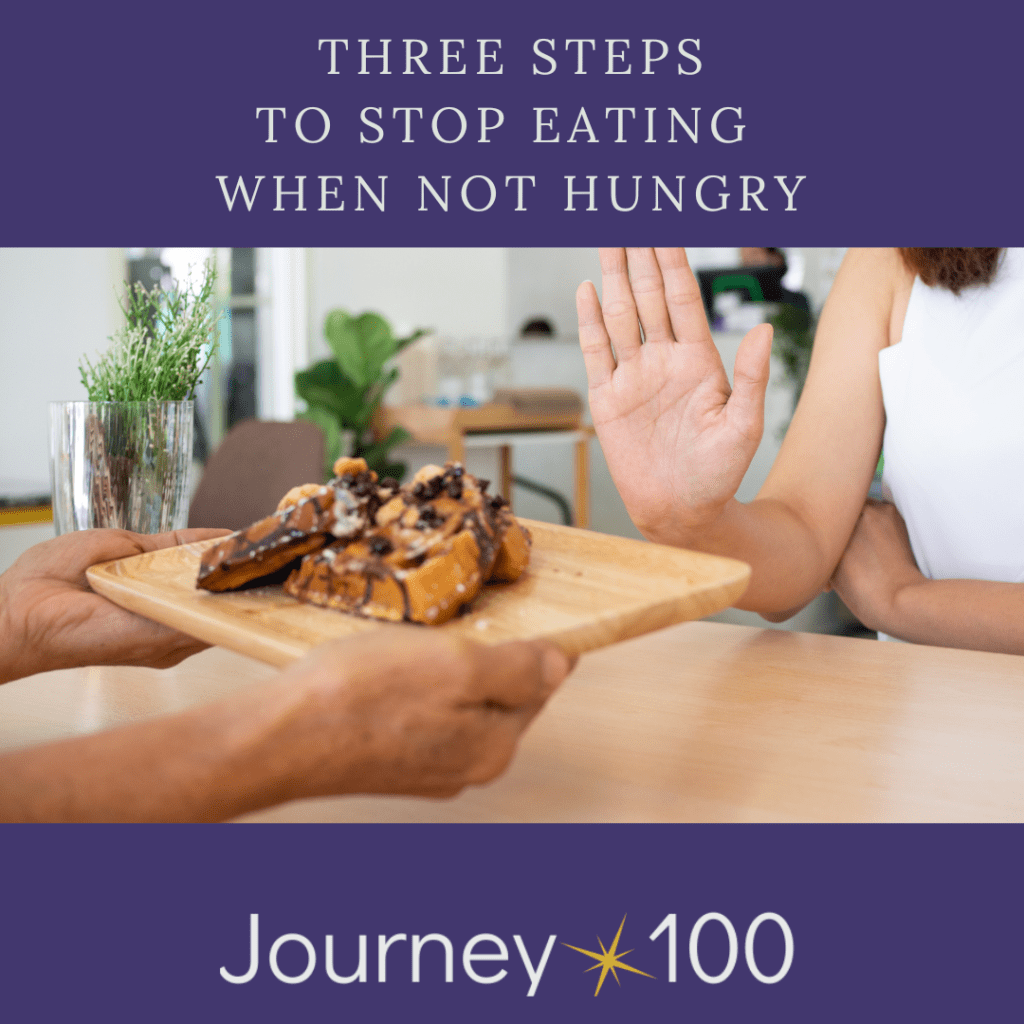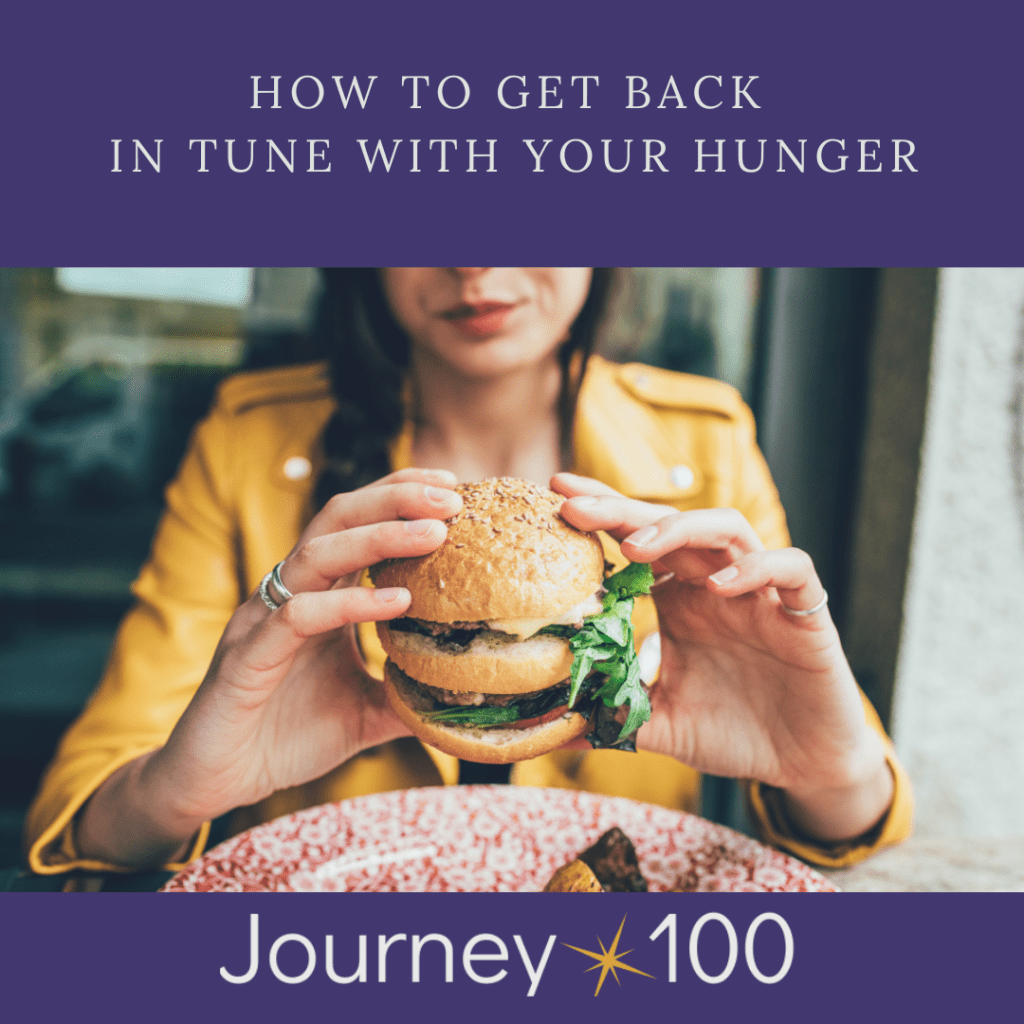Three steps to stop eating when not hungry

Eating when you are not hungry equals weight gain. And if you are on a weight loss journey that is a recipe for disaster! But how do you stop eating when you aren’t hungry? Follow these three steps to get back in tune with your body and stop eating when you aren’t hungry: Step One: Identify your hunger signs The first step to stop eating when you are not hungry is to figure out if you really are hungry. For many women this can actually be quite difficult. You’ve spent years eating by the clock, eating to relieve stress or eating because it simply feels good. To determine if you are physically hungry, drop into your body. What does that look like? Close your eyes. Ask yourself where do I feel hungry? For me, I know I am truly hungry when the middle of my abdomen feels a little tight. I also get slight growls in my stomach. If I have been truly hungry for a bit then the hunger starts appearing in the front of my head as a slight headache and I will feel my energy levels begin to dip. On the other hand, these physical sensations are not present when I am not hungry. Instead I will find myself “tasting” food in my mouth, like daydreaming about how good a Reese’s peanut butter cup would be right now. Sometimes when I am not hungry but WANT to eat, I will ask myself “Am I hungry?” and then soon enough I will feel a little tingle in my stomach. This is phantom hunger. It’s like a little ghost of hunger that comes pretty quickly after I get a craving for something. This isn’t true hunger. How do I know? Go to step two. Step Two: Take an inventory of your circumstance When I find myself wanting to eat when I’m not physically hungry, I take a moment to figure out what is going on in my life. One great way to do this is ask yourself “If I wasn’t going to eat right now, what would I be doing?” So often that 3pm hunger is actually being tired of work and not wanting to start another work task. In the evenings, I would be left alone with my thoughts about what I screwed up during the day, what’s left to be done tomorrow or thoughts of how I’m so exhausted and nothing really feels good in my life. Other times, I am just plain bored and want to be entertained! Once you figure out if you want to eat to avoid something in your life, then solve for that. If I am tired of work and don’t want to start another work task, then I take a 15-minute break and go for a walk, meditate or watch a couple silly tiktok videos (be sure to set a timer and don’t go beyond the 15 minutes!). If I’ve put the kids to bed and I don’t want to be left alone with my troubling thoughts, I break out my journal, jot down a quick to-do list for the next day, tell myself I’m a good wife and mother, then give myself permission to rest and relax. If I want to be entertained, then I snuggle in a blanket and watch my favorite show. Understanding what you truly need in that moment will help you understand and care for yourself better. When you start solving for what is actually bothering you, the less you will feel driven to eat at times when you are not hungry. If you’ve identified the non-food reason you want to eat when you aren’t hungry but still feel compelled to eat, continue to step three. Step Three: Do a hard reset Our brains present persistent thoughts of wanting to eat when we are not hungry simply because it is trying to avoid something in our life (see step two) AND there is not much else for it to do. On my weight loss journey, I found that continuing to push through and simply NOT eat was difficult. This was especially the case when I started working from home during COVID. I worked in the living room and thoughts about what was in the fridge started popping into my head. I’d ask myself “What would I be doing if I wasn’t eating” and the answer would generally be doing a work task. So I would acknowledge I didn’t want to do the work task, take a little break and then start the task anyway. But the thoughts kept coming. In those instances, I gave myself a protocol to help me reset. I would chug a giant glass of water, get outdoors for a five-minute walk and talk to myself. The magic in the reset is creating different sensations for yourself. The glass of water will help your body feel different on the inside (fuller and maybe colder). Getting outdoors will help you feel different on the outside (sun on your skin, wind on your face, maybe it’s warmer or cooler than your home). Finally talking to yourself. Be very specific in the things you say. This is a time to speak to yourself kindly and cheer yourself on. I often say “I’m so proud that I took this time to reset. I’m so glad that I am choosing my bigger goal over something I want in this moment. This is what self care looks like and I’m so happy I made this choice.” Final reminder: Even if you eat when you are not hungry, remember that it will never help to be unkind or berate yourself. Your weight loss journey will never be a straight line to your goal weight. Be open to learning when things don’t go as expected. If you are learning then you are always moving forward with better knowledge for the future. If you struggle with eating when you are not hungry, I can help. Schedule
How To Get Back In Tune With Your Hunger

At my high weight of 250 pounds, I was never really hungry. I was constantly eating and stuffing myself beyond fullness. The single thing that started me on my journey to losing 100 pounds was waiting to eat until I was actually hungry and stopping when I was satisfied. What is the Hunger Scale? I like to think of hunger scale as a number line. Zero is neutral, without a feeling of hunger or fullness. The negative part of the scale represents hunger and the positive part represents fullness. There are extremes to each side of the hunger scale too. At the negative part (-10), you have extreme hunger where you might have a lot of dizziness, nausea, headache and a depletion of energy. The other extreme would be stuffing yourself (+10) where you might feel like you can’t move without making yourself sick and have extreme stomach pain. Only eat when you are hungry (-2) The goal is to start eating when you are at a -2. This means you have clear signs of hunger. Your stomach might be lightly growling, you might be more distractible or you might have a slight dip in energy. This is the time that you want to eat. Please remember that every person’s signs can be different and you should define these signs for yourself. Stop eating once you are satisfied (+2) Once you begin to eat, your hunger lessens then disappears and you begin to enter the positive side of the Hunger Scale. At satisfied (+2), your body may feel light and energetic. Your stomach will not feel empty any more but it also will not feel the pressure of fullness. At this point of satisfaction, you are able to do light activity such as go for a walk without feeling uncomfortable. How to define your -2 to +2 There is no right way to define your hungry and satisfied points. These points are going to be as unique as you are. A great way to get better acquainted with your body’s cues it to check in with yourself before you start eating and ask yourself: Am I hungry? How do I know I am hungry? What signs is my body giving me? If the answer is I am hungry, then ask yourself to identify two or three ways that you know that you are hungry. Start using a journal to keep track of those hunger cues so you can identify patterns and really hone into what your -2 looks like. The very same can be done with your satisfied (+2) point. Stop halfway through your meal and evaluate the sensations in your body. Ask yourself: Do I have signs of physical hunger? Am I satisfied? What cues is my body giving me? If the answer is you do not have any feelings of hunger and you feel satisfied, then identify two or three ways that you know that you are satisfied. Track these signs in your journal too. Knowing the signs of satisfaction in your body will help you stop overeating and allow your body to shed your excess weight. What if I eat past +2 or -2? As with learning any new skill, you are likely to make mistakes along the way. This is expected and perfectly OK. Be sure to note the signs from your body and how you felt in those situations. Always be kind and reassure yourself that you are learning from this experience so you can stay within -2 to +2 in the future. Be patient and keep checking in with your body. Finally, be patient with yourself as you discover what signs your body gives for each side of the scale. You may also find, as I did, that during your weight loss journey the amounts of food that once brought you to satisfied are now taking you to a more full state (+4). This will happen as your body adjusts its need for food based on your new smaller body. Your Coach, Andrea Here is my gift to you. This is a printable Hunger Scale resource that you can use. I hope you enjoy it! The Hunger Scale
